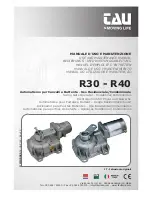
7
Duty cycle.
The Formula used to determine duty cycle is:
Run time
x 100 = Duty cycle
Run time + rest time
Working example 1: (Low duty cycle)
Run time: 17 seconds.
Rest time: 20 seconds.
17 ÷ 37 x 100 = 45.94
Thus the duty cycle in example 1 is said to be 45.94%
Working example 2: (High duty cycle)
Run time: 17 seconds.
Rest time: 1 second.
17 ÷ 18 x 100 = 94.44
Thus the duty cycle in example 2 is said to be 94.44%
The above examples do not factor in resistance and gate mass. These two elements contribute greatly to the amount of heat generated in your gate
automation system.
Below are the maximum allowed duty cycles based on the gate mass and rolling resistance for the ET motor models. These are calculated to conform
to the standards set out in the SANS 60335-95-1:2011 safety code.
Duty cycle capabilities guideline of the ET Drive series motor models:
Model
Gate Mass
Starting Resistance
Rolling Resistance
Max Duty Cycle
Drive 1000 -
ACDC option
≤ 1000 kg
≤ 40 kgf
≤ 30 kgf
98%
Drive 1000 -
Battery dependent option.
≤ 1000 kg
≤ 40 kgf
≤ 30 kgf
25%
Where to position the gate motor.
Liquid ingress:
The ET Drive series motor models all carry an ingress protection rating of IPX4. This means they are protected from splashing water. They are not
water tight as there are sensitive electronic and electrical circuits that require uninhibited airflow to remain cool and dry.
When deciding on an installation position, be aware of water collection points around and near the desired mounting position of the motor unit. If
the water does not flow away quick enough, it can seep into the system and cause expensive and possibly hazardous damage. Always install the unit
higher than the highest level, any water flowing past the motor unit can reach.
Physical protection:
Whenever possible, always install the gate motor on the opposite side of the gate’s guide/emergency post, to the driveway itself. This way it is out of
the path of the motor vehicles as they pass through the entrance/exit.








































